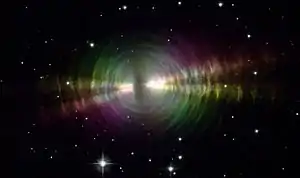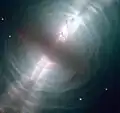| Reflection nebula | |
|---|---|
| Protoplanetary nebula | |
 RAFGL 2688, the Egg Nebula | |
| Observation data: J2000 epoch | |
| Right ascension | 21h 02m 18.75s[1] |
| Declination | +36° 41′ 37.8″[1] |
| Distance | approx[2] 3000 ly (920 pc) |
| Apparent magnitude (V) | 14.0[1] |
| Apparent dimensions (V) | 30″ × 15″ |
| Constellation | Cygnus |
| Physical characteristics | |
| Radius | 0.2[a] ly |
| Absolute magnitude (V) | 4.2[b] |
| Designations | RAFGL 2688,[1] The Egg,[1] Cygnus Egg[1] V1610 Cyg |
The Egg Nebula (also known as RAFGL 2688 and CRL 2688) is a bipolar protoplanetary nebula approximately 3,000 light-years away from Earth. Its peculiar properties were first described in 1975 using data from the 11 µm survey obtained with sounding rocket by Air Force Geophysical Laboratory (AFGL) in 1971 to 1974. (Previously, the object was catalogued by Fritz Zwicky as a pair of galaxies.)

The Egg Nebula's defining feature is the series of bright arcs and circles surrounding the central star. A dense layer of gas and dusts enshrouds the central star, blocking its direct light from our view. However, the light from the central star penetrates the thinner regions of this dusty enclosure, illuminating the outer layers of gas to create the arcs seen in this resplendent image (Hubble Site). Spectra of the starlight scattered by the dust reveal that the central star has a spectral type of F5.[4] The photosphere of an F5 star is about 900 K hotter than that of the Sun, but it is still not hot enough to have begun ionizing the nebula. Therefore the Egg Nebula is at a slightly earlier evolutionary stage than the Westbrook Nebula whose spectral type B0 central star has just recently begun to ionize the nebula.
The dusty enclosure around the central star is very likely a disc. The bipolar outflows in the image indicate that the system has angular momentum, which is very likely generated by an accretion disc. In addition, a disc geometry would account for the varying thickness of the enclosure that allows light to escape along the disc's axis and illuminate the outer layers of gas, but still blocks it from our direct view along the disc edge. Although dusty discs have been confirmed around several post-AGB objects (S. De Ruyter et al., 2006), a disc around the Egg Nebula is yet to be confirmed.
The Egg Nebula shows strong microwave emission from rotational transitions of carbon monoxide (CO) and hydrogen cyanide (HCN).[5][6] The presence of strong HCN emission indicates that the progenitor AGB star was a carbon star. Millimeter wave spectral lines from 38 molecular species have been detected in the outflow.[7] The CO and HCN spectra have a strong blue-shifted P Cygni absorption feature, and show the presence of a ~100 km/sec high velocity wind inside of the remnant AGB wind (which is expanding at 18 km/sec).[8]
The Egg Nebula was photographed by the Wide Field and Planetary Camera 2 of the NASA/ESA Hubble Space Telescope.
The Egg Nebula emits polarized light[9] which can also be detected visually by a medium-sized telescope.[10]
Gallery
 Image produced from exposures in visible and infrared light from Hubble’s Wide Field Camera 3.[2]
Image produced from exposures in visible and infrared light from Hubble’s Wide Field Camera 3.[2]
Notes
References
- 1 2 3 4 5 6 7 "V* V1610 Cyg". SIMBAD. Centre de données astronomiques de Strasbourg. Retrieved 2007-01-05.
- 1 2 "Hubble Images Searchlight Beams from a Preplanetary Nebula". ESA/Hubble Picture of the Week. Retrieved 24 April 2012.
- ↑ Hrivnak, Bruce J.; Lu, Wenxian; Maupin, Richard E.; Spitzbart, Bradley D. (February 2010). "Variability in Proto-planetary Nebulae. I. Light Curve Studies of 12 Carbon-rich Objects". The Astrophysical Journal. 709 (2): 1042–1066. arXiv:0911.2830. Bibcode:2010ApJ...709.1042H. doi:10.1088/0004-637X/709/2/1042. S2CID 119190352. Retrieved 3 June 2022.
- ↑ Crampton, David; Cowley, A.P.; Humphreys, R.M. (June 1975). "Spectroscopic observations of CRL 2688". Astrophysical Journal. 198 (L135–L137): L135. doi:10.1086/181830. Retrieved 15 November 2020.
- ↑ Knapp, G.R.; Morris, M. (May 1985). "Mass Loss from Evolved Stars. III. Mass Loss Rates for 50 Stars from CO J = 1--0 Observations". Astrophysical Journal. 292: 640–669. doi:10.1086/163197. Retrieved 26 November 2020.
- ↑ Bachiller, Rafael; Forveille, Thierry; Huggins, Patrick J.; Cox, Pierre (August 1997). "The Chemical Evolution of Planetary Nebulae". Astronomy and Astrophysics. 324: 1123–1134. Bibcode:1997A&A...324.1123B. Retrieved 26 November 2020.
- ↑ Qiu, Jian-Jie; Zhang, Yong; Zhang, Jiang-Shui; Nakashima, Jun-ichi (April 2022). "Molecules in the Carbon-rich Protoplanetary Nebula CRL 2688". The Astrophysical Journal Supplement Series. 259 (2): 56. arXiv:2204.02796. Bibcode:2022ApJS..259...56Q. doi:10.3847/1538-4365/ac5180.
- ↑ Young, K.; Serabyn, G.; Phillips, T.G.; Knapp, G.R.; Guesten, R.; Schulz, A. (20 January 1992). "The Multiple Molecular Winds of CRL 2688". Astrophysical Journal. 385: 265–272. doi:10.1086/170934. Retrieved 26 November 2020.
- ↑ Raghvendra, Sahai; et al. (January 1998). "The Structure of the Prototype Bipolar Protoplanetary Nebula CRL 2688 (Egg Nebula): Broadband, Polarimetric, and H2 Line Imaging with NICMOS on the Hubble Space Telescope". The Astrophysical Journal Letters. 492 (2): L163–L167. Bibcode:1998ApJ...492L.163S. doi:10.1086/311108.
- ↑ "Proto-planetary Nebulae". Retrieved 6 July 2013.
- Hubble Finds Searchlight Beams and Multiple Arcs around a Dying Star. STScI Press release: Space Telescope Science Institute. January 16, 1996.
- De Ruyter et al. Keplerian discs around post-AGB objects: a common phenomenon? Astronomy & Astrophysics 448, 641–653 (2006).
External links
- Merrifield, Michael. "Egg Nebula". Deep Space Videos. Brady Haran.